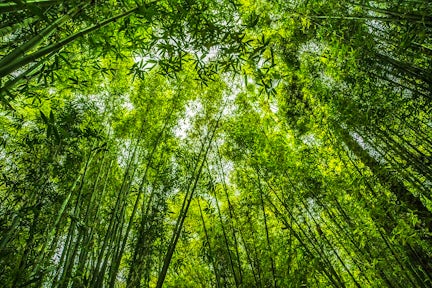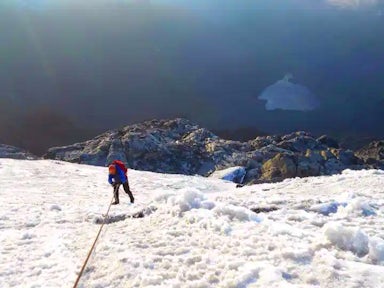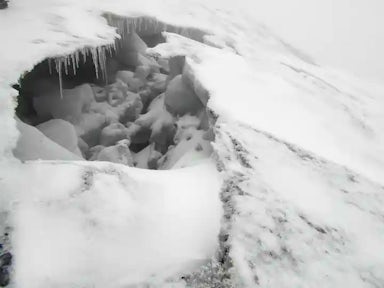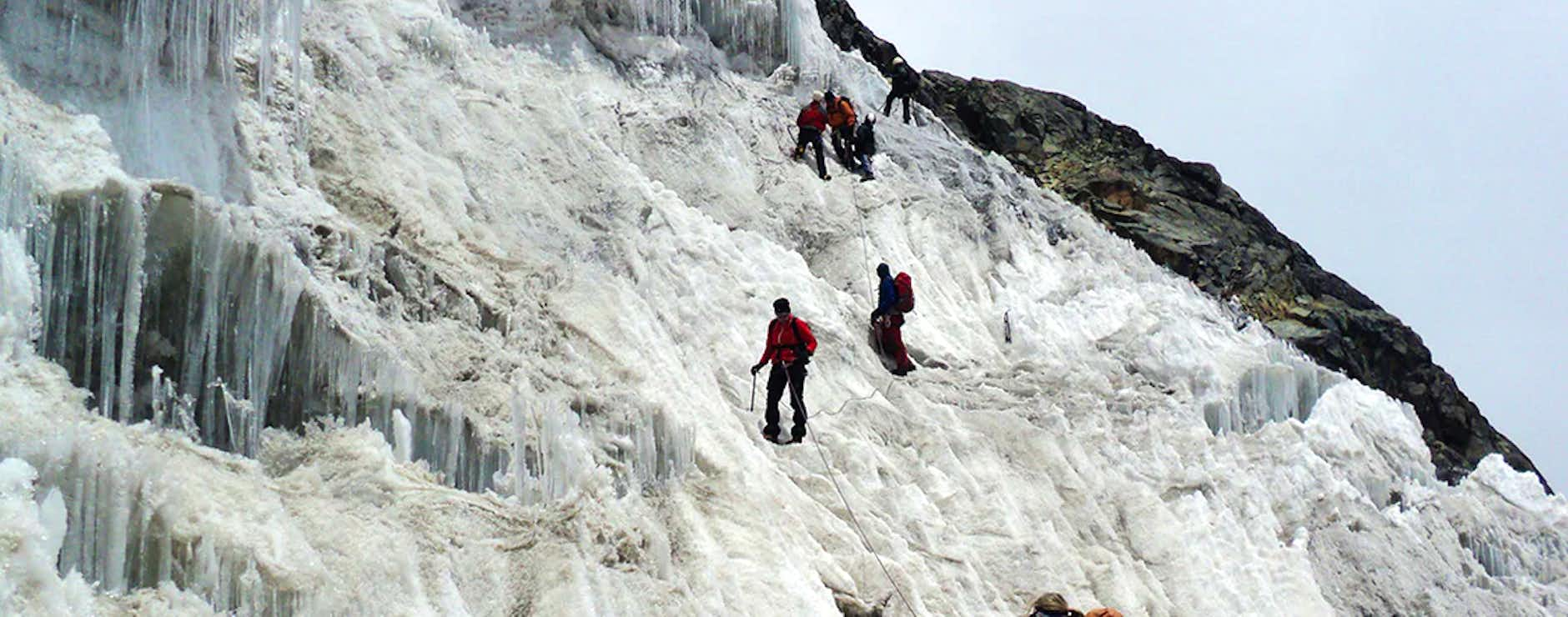Day 1: The Adventure Begins
Rain has poured intermittently since we got here; off of leaves and onto heads, drenching us until clothes merged with skin. It’s not completely unwelcome - the showers offer some relief from the muggy weather. Entering the valley, heading deeper into the Afro Montane Forest Zone, it’s easy to understand why they call these the Rwenzori ‘rainmaker’ Mountains.
We’re roughly 1,600 metres up, and I’ve taken a moment to pause to catch my breath. To my right, a small chameleon curves himself around a slim branch, swaying back and forth as wind collides with the trees above. He peers up with round eyes, watching me as closely as I watch him. For the most part he’s marbled a brilliant green and royal blue, dashed with bold yellows across his back and his face a rich, friendly ochre.

The walk continues at a good pace, a steady climb uphill the whole way. The rain slows, and eventually stops. The sun now breaks through here and there, and through the treeline we catch glimpses of the clouds rolling over the green knolls of the forest slanted above, gently dimming the colours of the forests before they’re dialled up again as the sun re-emerges.
Breaking for lunch now. We have just entered the Bamboo-Mimulopsis Zone. The trek here is much steeper than before, dirt shifts and moves underfoot after the rainfall. It requires some focus to stay upright!
Before arriving at the camp, we pass through the Heather-Rapanea Zone. I can’t help but be in awe of the trees during this section of the trail. They bend in soft arches to the left and right, weaving away from one another and reaching out towards the sky with delicate limbs. Moss covers every trunk, every branch and every rock in soft blankets of glass bottle greens that glint slightly with the dampness of rain.

Heather floats from beneath the branches in sheer, lacy clouds. They drape elegantly down towards us, and appear almost fragile, as if to reach out and touch them would make them disappear. You begin to think you’ve stepped into a Tolkien novel, surrounded by a world I can never hope to completely explore or fully understand.
Kalalama Camp soon emerges ahead of us in a small clearing - here is where we will spend our first night in the Rwenzori Mountains.
Sitting alone in the dim evening light, perched on a small bench just outside the sleeping huts - it’s the first time I’ve been off my feet for more than 30 minutes all day. The camp is welcoming - made up of a few brightly coloured huts built close together. The rain has begun to gently fall again, droplets bounce of the metallic roofs of the huts - the noise is dull and tinny. Birds call out to one another overhead, and after sipping my last drop of tea, I clamber into the top bunk of my hut.

Day 2: Kalalama Camp to Bugata Camp
We started early today. I shuffle out of the hut towards some chairs set up by the guides for breakfast. Thankfully, today is set to be drier than yesterday. We’re over 3,000 metres now, and the morning air is crisp and sharp. The sky is a beautiful azure, and the crescent of the moon is still visible above the far ridges.
After a great breakfast (it’s amazing what the chefs can whip up at 3,000 metres in the mountains!), we begin the day’s trek. We traverse through the grassy knolls of the ridge, bypassing another camp, pausing now and then to point upwards at the boughs of the trees, tracing the flight of the Turaco birds that circle above.
Walking slowly with knees bent, we trail down into the valley, navigating dabbling streams and stopping for rest opposite waterfalls that cascade from lichen blanketed rocks above. The noise was a soft roar as water met water just in front of us, the spray carried away by a slight breeze.

A couple of people branched off to take photographs from different angles, and I watch them step precariously over slippery stones and back again to rejoin the group. The moment of serenity passes as we regather and resume our ascent of the mountains. At this point, we are at roughly 3,800 metres, just about to enter the boglands of the Rwenzoris.
Placed carefully between Heather trees throughout the Mutinda Valley are man-made boardwalks, muddied by other explorers, slightly flaky and decorated by pale lichens. With each step, the boards creak and squelch; a rhythm that helps us keep a solid pace. Punctuated along the pathways are Giant Lobelias with flowers of brilliant purples and reds. We walk carefully between them, laughing about how out of place they’d look in our own back gardens.
Quickly, the trail ascends again, taking us higher up the Namusangi Valley and towards Bugata Camp. The acclimation to these new heights is slow and steady. With the pace we’re keeping, I can feel the effects of the altitude now, but deep breaths and rest-stops keep it at bay. I only notice it in the more quiet stretches of the hike, in those brief moments when you’re not admiring a view or joking with your guides.

We’ve now made it to our second camp and the views here are beyond amazing. We are in Bamwanjara Pass, overlooking the Bugata Lake. The lake bulges in shape at the sides, tapering into two neat points at either end. It’s an inky sort of blue; perfectly reflecting the sky above it. From lower angles, the peaks of the ridge around the lake appear like jagged cracks on the water's surface, mottled and pale. In the distance, I can make out the shadow of Weismann’s Peak, its snowy cap fading into the clouds that linger around it.
A moment ago, a woman behind me gasped and waved her hand frantically to get our attention. Emerging from the treeline was a small red antelope - a Rwenzori Duiker - our guide explained. These are endemic to the Rwenzoris. His face was small, his steps tentative but deliberate. A branch cracked under someone's shoe as they edged closer to get a better look, and the Duiker retreated into the bush as quickly as it had appeared.
We settle down for dinner at the camp, the views are extraordinary here and there’s a real sense of community building within the group. We’ve got two days under our belts now, and we’re close to breaching 4,000 metres.

Day 3: Bugata Camp to Hunwick's Camp
Another early morning, which once again gives the gift of stunning views in gentle morning light. After breakfast and coffee, we leave Bugata Camp. We pass along a ridge that’s so narrow we have to walk single file, putting one foot directly in front of the other. Boulders worn smooth by gnarled tree roots arch upwards, acting as stepping stones along our journey towards Bamwanjara Pass at 4,450 metres.
The gravelly pathway through the pass is bleached in comparison to the dark moss that covers the rock formations either side. They jut out at strange and sharp angles, yet provide little shade as midday approaches. Ahead, we can see three towering peaks, and pause for a moment to watch as clouds settle in front of them.
We descend into another valley this afternoon - boardwalks have been firmly placed into the ground here, stretching straight ahead as far as I can see. It’s by far the sturdiest and easiest walk we’ve had in a while, a welcome change of pace from the rocky trails and craggy paths of the morning’s hike.

Stretching out either side of us is thick, evergreen vegetation. Every now and then we spot a Malicite Sunbird leaning into the flowers of the Lobelia to feed. Quickly, the trail becomes steep once more. I find myself missing the flatter terrain at the entrance of the pass as we steadily climb up part of the trail that curves to the left and right and back again.
It’s early evening, and we’ve reached Hunwick’s Camp at the top of the valley. This is to be our nest for the night. Situated at roughly 4,000 metres, it overlooks many of the great sights we came to the Rwenzori Mountains to see: Mt. Stanley, Mt. Baker, Weismann’s Peak, McConnell’s Prong. It’s completely wild here, with towering massifs draped in forestry, it’s an almost Jurassic scene.

Day 4: Hunwick's Camp to Margherita Camp
I woke up well before we were due to leave this morning, my body clock has finally adjusted to the demands of the trail. There was some slight rainfall throughout the night, the ground is soft beneath my boots this morning. The air smells rejuvenated and crisp, the leaves of the undergrowth gleam in the early morning light as the sun breaks through the low clouds.
From Hunwick’s Camp, we pass down and through yet another of the Rwenzoris many valleys. The descent feels easier on my legs after the steep climb yesterday, and I follow the slight ledges emerging from the moss, stepping over entwined roots and fallen branches. The forest here is denser than I’ve seen it since the beginning of the expedition, they lean in towards us, dripping heather and vines overhead. Here and there, some have completely unrooted after being struck down by a past storm. They lay there against the earth in a small clearing of their own creation.

Eventually, the forest becomes sparser, the trees bare and the thicket closer to the ground. Here, the clouds press closer too, shrouding the valley in a mist that obscures our vision past a couple of metres. But we press onwards, heads down, tracking the pathway under our feet one step at a time.
Lake Kitendara soon reveals itself to us as we emerge into the base of the valley. It’s as deep and still as its sister lake, except this one has a small peninsula of rock that interrupts the smooth shape of its shore. It’s distinctly marbled with lichen in shades of black and off-white. Thin trees sprout from it intermittently, reaching downwards towards the surface of the lake as though they were bending to take a drink from it.

Passing between two ridges that flank the valley, we climb up Scott Elliott’s pass. It is a jagged pathway of dark rock, quite brutal in appearance against the ever-thickening clouds. They were softened only by the sheet of frost that had settled on their surface and the delicate white flowers that had rooted deep into the cracks.
We’ve now arrived at Margherita Camp at approximately 4,500 metres. The cabins here look like elongated garden sheds nestled beneath rocks that will shelter us from the strong winds. Smoke pours from a narrow chimney, welcoming us and promising warmth inside. The day has been long and tomorrow will be longer with our earliest start yet. We’re approaching the alpine zone of the Rwenzoris - swapping verdant forests and still lakes with massifs decorated by snow and ice.

Day 5: Mt. Stanley & Margherita Peak
It’s about 2:30 in the morning, the sun has yet to break. Today we will climb Mt. Stanley, the aim is to get to Margherita Peak before 10am to avoid any oncoming bad weather. If it doesn’t look like we’re going to make it, we’ve been told that the safest thing to do is just turn around and come back to camp.
A couple of people have opted to venture up to a vantage point on Stanley glacier instead. Their day will take them to the rocky outcrop of the southern edge of Alexandra Peak, from there they’ll be able to see over the Congo and the lower mountain ridges.

Clad in gear, we begin the ascent to the peak. In a single file, we grasp onto a thin rope that leads us up a flat part of the mountain's edge. I can’t see much to the left or to the right of me, and so instead focus on the rhythm of my hands and feet moving in time with one another, my crampons clinging to the slope with each step.
Eventually the climb evens out a little, and we edge across the side of the mountains to reach a higher ledge. I’m careful to step into the footprint of the person just before me, pausing now and then to allow them space. In these moments, I look up at the blank canvas that is this part of the Rwenzoris. Undisturbed - apart from our own steps - the snow looks a brilliant white, interrupted only by eruptions of rock that loom above us. Hanging from these rocks are thousands of icicles, some so big you dare not go near them.

We pass under them, climbing upwards to the shelf of ice hidden on the other side. After pulling myself up, I wait with the others for the rest of our party. The ice here takes on a strange shape; the wind has sculpted it somehow. Upwards still, the peak just ahead. Now at well over 5,000 metres, my breath is sharp in my lungs, and my cheeks sting red in the wind.
As we reach the peak, we all take a second to gather ourselves. We look around, almost bewildered that we made it here. There are high-fives and celebratory hugs before crouching around the signpost that marks Margherita Peak for pictures.
We spend some time admiring the view and revelling in our accomplishment. Eventually, it’s time to head back down.


